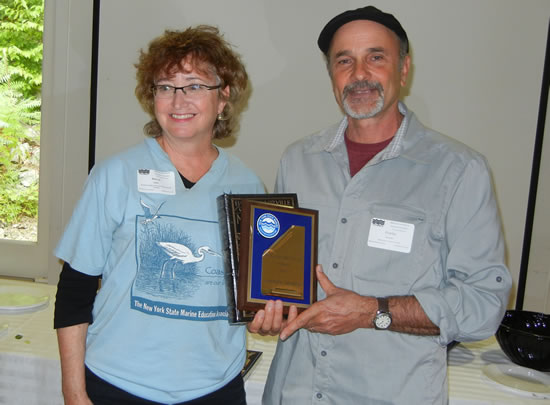Teaching On The Hudson
By Yehuda Bayme

(L-R) Dr. Merryl Kafka & Charles Denson
When one thinks of the Hudson, although steeped in patriotic history, it is hard to avoid labeling it with industrial pollution, sewage, and tetanus. But for members of the New York State Marine Education Association, or NYSMEA, it is a hotbed of scientific data. The amount and quality of information researchers are observing on the Hudson gives the river significance in the natural world that would have been for the most part overlooked by the average person. NYSMEA is an organization that promotes awareness of marine studies, encourages growth and exchange of instructional resources within the scientific, educational and commercial communities. The organization, ably headed by president Dr. Meghan Marrero, a professor at Mercy College, provides excellent educational programs for students of all levels through boat trips and workshops.
What is it about the Hudson that we love? As one travels south to New York City, the river becomes larger until it merges with the Atlantic at the New York Harbor. As one drives down the West Side highway, one can see the little waves, the birds, the sailboats, the barges, and the charming and industrial cities of Fort Lee, Hoboken, and Jersey City. One may recall the heroic rescue efforts of plane Captain “Sullie” Sulzberger who used the Hudson for an emergency landing. However, how often do we stop to consider the Hudson River? Shouldn’t we be more aware of the very environment we live in? The members of NYSMEA and their affiliates are driving at this exact point. At their Annual conference this past September, in collaboration with the Black Rock Forest Consortium, NYSMEA introduced teachers, principals, professors and marine biologists to their studies of the river with lectures, workshops, and field trips in a weekend adventure.
Keynote lecturer, Dr. Tim Sugrue, President and CEO of the Beacon Institute for Rivers and Estuaries, discussed collecting data on the Hudson and how technologies in the form of monitors planted along the Hudson are being used to extract changes in temperature, salinity, and pressure that may occur. Changes could mean that important ecological events may be taking place. He discussed the devastation that Hurricane Irene had inflicted on upstate New York and required his staff to get new funds for his projects. The Beacon Institute has teamed up with Clarkson University in their efforts to advance the study of the sciences.
In a very interesting workshop entitled “A Day in the Life of the Hudson River,” the group heard Dr. Margie Turrin, the education coordinator at the Lamont-Doherty Earth Observatory of Columbia University and an expert on marine geology and geophysics, explain the salinity or salt content of the Hudson. She said that because the river connects with the ocean for a number of miles, its freshwater from the north is mixed with the saltwater of the Atlantic. Fish from freshwater sources and saltwater sources do not often mingle, but in the Hudson River estuary near Manhattan, the Bronx, and Westchester, it can occur more often. This anomaly makes New York City itself a potentially optimal place for diversity in marine life. Just like the city is a melting pot of people, so too are the populations under the surface of its water sources.
Dr. Turrin organized individuals to find the salt content from water samples in tubes taken at different locations near the harbor. The samples closest to the harbor had salt of twenty-six parts per thousand. The samples in Yonkers had a significant decrease of seven parts per thousand, and the samples a few miles further up had an increase of eleven parts per thousand. The content up the river decreased unexpectedly in Yonkers due to a tributary of freshwater that meets the Hudson at that point. Saltwater fish, if strong enough to swim can venture further inland and find refuge. The silverside fish, a resident of salt water, is an indicator of salinity; its absence indicates fresh water.
Chris Bowser, a member of the New York State Department of 50 Environmental Conservation (NYS DEC) and a fish expert presented to his group a variety of fish from the Hudson River. Together with Dr. Turrin, he showed the group fish in a basin of water: a wild goldfish, a catfish, a striped bass, a river sole, a northern king fish, and a beautiful northern pike fish. Mr. Bowser and Dr. Turrin also observed that there has been an influx of unusual fish in deeper parts of the Hudson after Hurricane Sandy. Herring and needlefish, both small in size have found ways of habituating, though not in large groups, but significant enough to be seen regularly. What Sandy proves is that our river’s biodiversity can change from unusual events too.
Among other presentations, the group got to see a workshop on frogs by Nalini Mohan of the Wildlife Conservation Society, a discussion on trout species native exclusively to New York, delivered by Jack Caldwell of the Black Rock Forest Consortium, and field trips, which included canoeing, and a strenuous hike to the Black Rock Summit.
Scientists and educators should take advantage of NYSMEA, an organization that is dedicated to educating schools and communities about the richness of marine life in New York. Education workshops such as these can also inform decision makers in business communities to responsibly use these resources. It was very exciting to see first hand the passion and expertise of the educators.#
